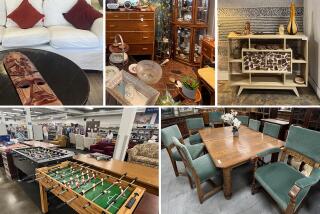Me and My Icon
- Share via
THEIR GOAL WAS TO BUILD A BETTER SOCIETY, and that they did--countless homes and commercial spaces today are furnished with the sleek, vibrant designs of Charles and Ray Eames, the husband and wife who operated out of a former garage in Venice in the mid-20th century. Entranced with the period’s breakthroughs in science and technology, the Eameses embraced the new discoveries, fashioning furniture out of plywood, plastic, wire mesh and aluminum and creating their landmark home in Pacific Palisades out of steel and glass. They also wanted the streamlined furniture they produced to be functional and affordable for the families of postwar-boom America. Today through Sept. 11, the Los Angeles County Museum of Art is hosting “The Work of Charles and Ray Eames: A Legacy of Invention,” an exhibit chronicling the designers’ artistic and cultural impact. On the following pages, members of the Eames fan club show off their favorite pieces.
*
ANN MAGNUSON
“I love the cards--they’re a perfect metaphor for life in Hollywood,” jokes actress Ann Magnuson of the Eameses’ Original House of Cards. This House of Cards never collapsed, however: the Eamses’ deck has been in continuous production since 1952, with the 54 cards, each with slots on the sides, meant to be joined into different three-dimensional shapes. Magnuson, who is featured in the upcoming “The Caveman’s Valentine,” lives in a 1939 Richard Neutra house and is a fan of the simplicity and idealism in mid-century architecture and furnishings. “This is design by people who believed that art could be part of everyone’s life.” Appearing on the faces of the Eames cards are familiar everyday objects such as scissors, spools of thread, matches and coins--what the Eamses called “good things.” “They remind me of my grandmother, who was very artsy-craftsy,” says Magnuson. “She transformed ordinary things--bits of old cloth, beads and yarn--into tiny dolls. Like the Eameses, she was fascinated with simple things.”
*
EAMES DEMETRIOS
“Most people see the Eames house as a modern icon,” says Eames Demetrios, grandson of Charles and Ray Eames, of the Pacific Palisades house that broke new ground with its unique construction. “But to me, it’s always been my grandparents’ home.” Demetrios, who is director of the Eames Office, which oversees the legacy of the original design studio, recalls sitting in the cozy living room alcove around a coffee table that the couple designed, discussing everything from photographing spider webs to their fascination with the American circus. “They were interested in everything.” To commemorate the 50th anniversary of their Case Study House No. 8, a limited edition of 500 30-by-45-inch gilt-over-brass copies of that table will be issued through Herman Miller, the company that has produced Eames furniture since the mid-’40s. “I keep it just as they left it,” Demetrios says of the original table, which is topped with objects that caught the designing couple’s eye: an abalone shell, glass prisms, a caliper, small boxes, a large gold star. “They looked at the objects as research, a sort of design shorthand for inspiration.”
*
HSIN-MING FUNG
Husband-and-wife team Hsin-ming Fung and Craig Hodgetts of Hodgetts + Fung, the architects responsible for the concept development of the traveling Eames show, own his-and-hers LCWs (Lounge Chair Wood). They were designing an electronics show exhibit to display new Microsoft games and wanted to do an entire environment in red, but were having trouble finding attractive chairs in that color--until they turned to the red-stained ash-face veneer LCW. By the end of the exhibit, they liked the chairs so much they decided to take them home. They now keep company with eight reissued DCMs (Dining Chair Metal) as well as several vintage Eames pieces that the couple have collected over the years. “Although one would think that plywood chairs would be very hard, you can literally sit in them for hours,” says Fung. “The seat is wider than most dining chairs and allows you a lot of wiggle room.”
*
DON MENVEG
Don Menveg fell in love with its shape, but it was the lifesaving features of the leg splint that the Eameses designed for the U.S. Navy in World War II that made it so valuable then. “I found my Eames splint in an Army surplus store in the early ‘70s,” says Menveg, associate art conservator for the Los Angeles County Museum of Art, who is among those responsible for conserving the furnishings and wooden artifacts for the exhibit on the designers. Menveg paid $2 for the splint, one of 150,000 that were manufactured for the Navy and were made of lightweight but resilient molded plywood with a birch or mahogany veneer. Now they carry a price tag of $200 and up. Charles Eames, who believed that designers should provide solutions to human problems, later received letters from the Navy extolling the splints. A former student of sculpture, Menveg kept the splint hanging above his studio workbench for inspiration before placing it in LACMA’s permanent collection: “I just love the sculptural aspect of the piece.”
*
MARIAH O’BRIEN
It was the first piece of furniture they bought for their home, says actress Mariah O’Brien of the reissued Sofa Compact, first designed by the Eameses in 1954, that now graces the 1960 Los Angeles house she shares with actor husband Giovanni Ribisi and their 2 1/2-year-old daughter, Lucia. The dramatically high back section on the original sofa folded down for easy shipping or storage; today’s version offers the same look but doesn’t double over. O’Brien, who stars in the independent film “Ordinary Madness,” considers her sofa, with its urethane cushions, a work of art. “It’s so simple and beautiful, yet amazingly comfortable--it hits you in all the right places.”
*
PETER LOUGHREY
Auctioneer Peter Loughrey, owner of Los Angeles Modern Auctions, wouldn’t dream of parting with his 1957 white leather Eames Lounge Chair 670--often described as a 20th century version of a 19th century English club chair and extremely rare in the world of Eames collectibles. “The general public refers to it simply as ‘The Eames Chair,’ it’s become such an icon,” says Loughrey. Herman Miller began marketing the chair, composed of three molded-plywood shells with padded leather cushions and rosewood veneer, in 1956, and it has remained in continuous production ever since, although the veneer is now made from cherry or walnut. “Herman Miller initially offered it in black or white leather, then discontinued the white when not enough people ordered it,” explains Loughrey of his chair’s rarity. “It’s undoubtedly one of the most important chairs of the 20th century.”
*
DEBORAH SUSSMAN
Graphic designer Deborah Sussman of Sussman/Prejza & Company in Culver City, who created the graphics for the 1984 Olympic Games in Los Angeles and, more recently, for Santa Monica’s Big Blue Bus, came to the Eames Office as a summer intern and “became one of the family.” While the Eameses were traveling in Germany in 1955, she designed various elements for The Coloring Toy, an Eames design that was produced by Tigrett Enterprises. “Ray and Charles always had all sorts of toys around. They asked me to fool around with some ideas while they were away,” Sussman recalls. The result: cardboard sheets printed with a variety of die-cut shapes for kids to punch out, color and put together with small braids that could be strung into whimsical creations. “It was intended to stimulate the imagination and at the same time encourage the understanding of color,” says Sussman. “The discovering-child is something many people lose as they grow older--the Eameses never lost that quality.”
*
ADAM GOLDBERG
“It’s good for cocktailing and socializing in--the one day of the month I’m at home,” quips actor-filmmaker Adam Goldberg of his molded-fiberglass and resin Eames rocker. The inexpensive armchair shell was initially offered with several possible bases, including birch rockers on wire struts, and listed for $38.20 in Herman Miller’s 1952 catalog, epitomizing the Eameses’ desire to create low-cost furniture for the postwar market. Goldberg, whose current projects include the upcoming TV series “The Street” and the suspense thriller “Salton Sea,” received the rocker as a Christmas gift from his father. “He knows I like Eames and other mid-century stuff,” says Goldberg. “I also love films from that era . . . . I want to raid the households of those sets.”
*
Ann Magnuson’s hair: Katja Fenchel/New Vidal Sassoon; makeup: Stefanie Grizzelle/New Vidal Sassoon. Mariah O’Brien’s hair: Feliz del Prado/New Vidal Sassoon; makeup: Stefanie Grizzelle, New Vidal Sassoon. Adam Goldberg’s groomer: Melissa Stone/New Vidal Sassoon






